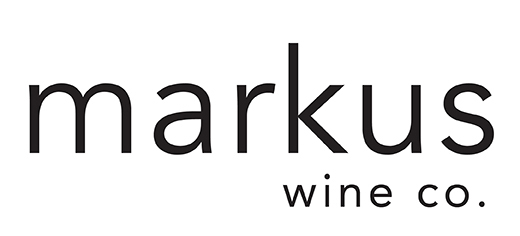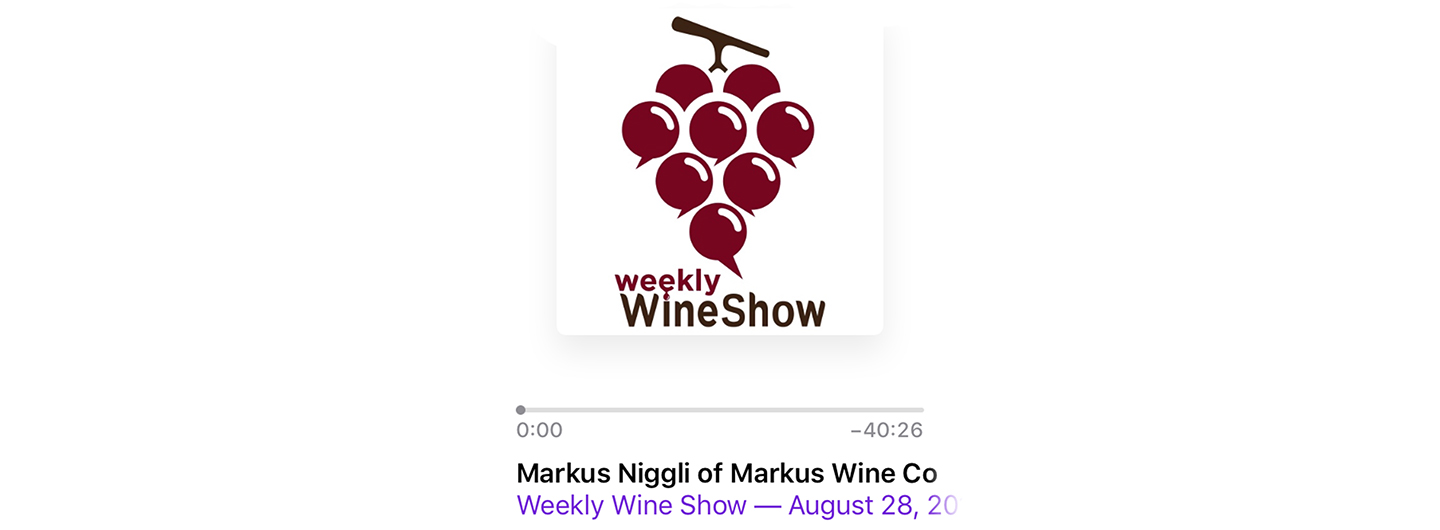One very good podcast we listen to regularly is the Weekly Wine Show, produced by Tony and Betty Notto out of Minnesota. Over the last few years, we’ve enjoyed hearing their understanding of wine growing to the point where both beginners and more-experienced wine drinkers will appreciate what they bring to the table.
Markus had the privilege to skype with Tony and Betty on August 24th for this episode 130 they posted on August 28th. Even for us, it was interesting hearing all of Markus’s story and philosophy from ground zero.
Please enjoy this podcast and the transcript following, and let Tony and Betty know what you thought over at Weekly Wine Show: bit.ly/MarkusWWS130
Betty:
I’m Betty Notto.
Tony:
And I’m Tony Notto.
Betty:
We’re on a journey to learn more about wine and how to enjoy it. And we want you to join us.
Tony:
So, welcome to Weekly Wine Show, and let’s talk about wine.
This is episode 130, and this week we are featuring our interview with Markus Niggli of Markus Wine Company out of Lodi, California, and some of his amazing wines.
We met Markus back in 2016 when the Wine Bloggers Conference was in Lodi, California, where he was involved with the pre-conference excursion we went on, which was titled, “Old Vines and Experimental Wines.”
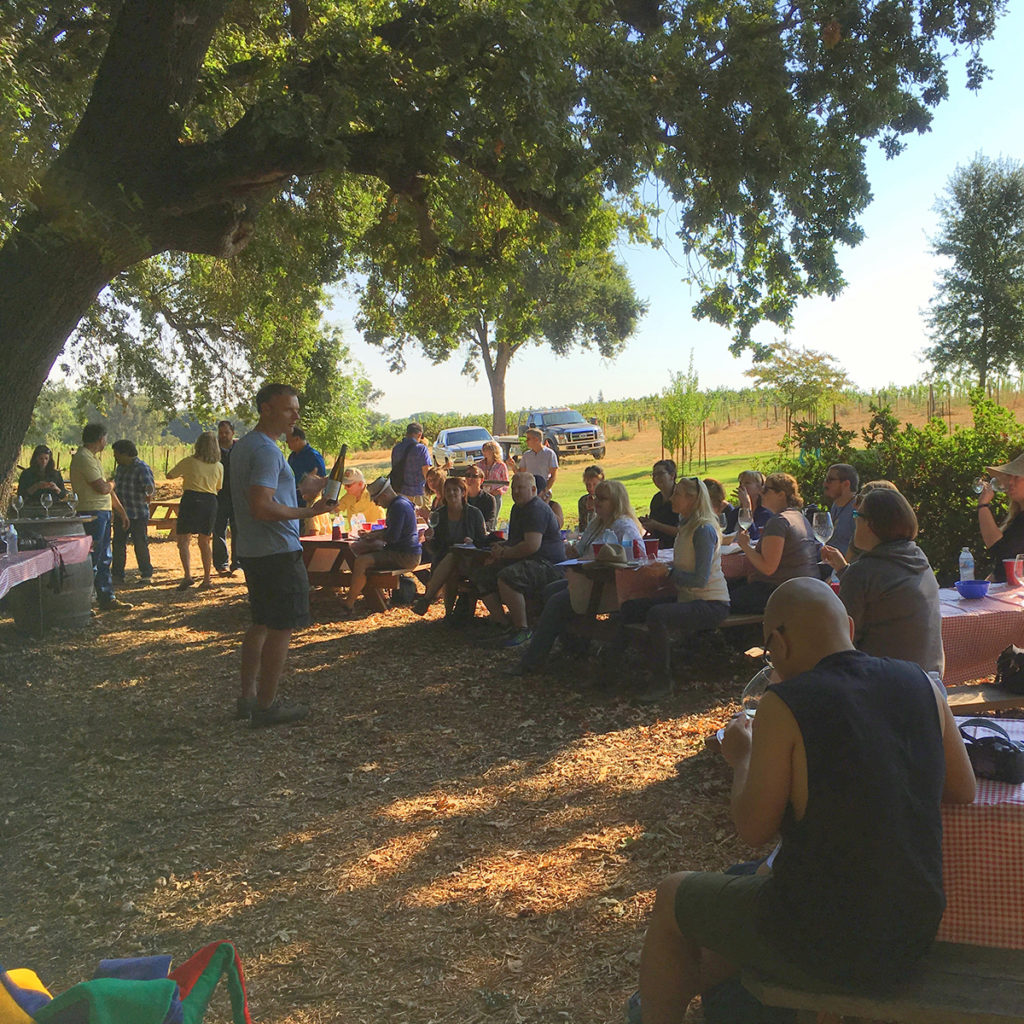
Markus was indeed sharing fresh wines with higher acidity made with grapes you wouldn’t expect in a place many people believe was too hot to do so; wines like his Gewürztraminer, which we raved about back in episode 25.
Betty:
Markus, thank you so much for joining us.
We are going to start like we start most of our interviews with winemakers: just tell us a little bit about your wine journey and how you got started in making wine.
Markus:
Yes, thank you guys for having me on the show.
It was not planned to be in the wine industry at all.
I started out working in the tourism sector, and my work got me to a lot of different destinations around the world. So, with being traveling and being on the plane constantly, and liking to drink wine, a friend of mine, who was working in Switzerland as a wine importer, he actually asked, “Hey can we make a deal that you give me cheap tickets and I will introduce you to all the winemakers around the world?”
And I said, “Wow, yes of course let’s do that!”
So, we flew together to Australia, of course to United States – back then I was living in Switzerland – all over Europe, South Africa, etc. And that really opened the door to the world of wine never seen before through my eyes.
And I told myself, “When I’m thirty years old, I will quit what I’m doing, and I will start over and make wine.” And that’s what I did.
And on my thirtieth birthday I did resign. And I flew to Australia and studied viticulture – so the grape growing part – and after a year-and-a-half I flew to the United States; lived in Santa Rosa for a little while; I worked in Napa Valley a couple seasons before I moved to Lodi afterwards.
And that was fifteen years ago.
Tony:
Great.
Can you tell us a little bit about where you make wine, and kind of what makes it unique compared to other regions, and was there anything that went into your decision, I guess, to settle there?
Markus:
Yes.
So, as I mentioned I worked a little bit in Australia on the West Coast in the Swan Valley, that’s where the basic practice happened.
And then I had the opportunity to work a few places in Napa. It was a very interesting experience, but it was very well-focused only on Cabernets, Sauvignon Blancs, a little Chardonnays, and that was pretty much it.
And the opportunity gave itself; an opening happened in Lodi.
And Lodi back then was not really on too many radars, actually, and I heard from others that in Lodi you can do things how you want to do it. You can be crazy. You can make new blends. New varietals are coming up, and they give you much more freedom, also financially, because the grapes in Lodi are not as expensive as in Napa Valley. There’s plenty out there, because Lodi is the biggest grape growing area in the United States.
And so the availability of the grapes were there to create and make. And I’m always thinking a little bit outside that box. And, so I’m really, really interested in working with varietals people haven’t worked with – or is crazy to work with – that nobody thinks that they’re coming from that particular region.
So it’s a good challenge, and it’s really something you don’t see everyday. And it was a little bit scary in 2006, actually, because Lodi was really just about to get the word out that they’re doing some decent wine there, but what happened in the past ten years really change the wine world and Lodi really made itself present on that map for all the wines produced out of this region.
And it’s really great that we have now today over a hundred and twenty different varietals coming out of this place.
Betty:
Yeah. Absolutely.
I know when we were there two years ago that was something that was really surprising, and it was great for us to see all the different styles and varieties coming out of the area. I mean, we just assumed it was just Zin. And so it was really great to be able to sample your wine and other producers wine who are doing some really interesting things with varietals that we didn’t think would grow in that part of California.
Markus:
Yeah, it’s correct. I mean you look at the past: Lodi was known at the very early stages really for the red Tokay grape, and then once that that time window passed we went into the White Zinfandel back in the ‘80’s when the Beringer and Sutter Home’s – all these blush wines, the sweet blush rosés – they’re all coming, the grapes were all coming from Lodi. And, it actually – probably did – hurt more the region then it did any good, because it’s just a mass production.
And after that vintage is passed, then we moved on to the “Capital of Zinfandels.” So, we were really the capital of Zin, Zinfandel in the United States.
And from that point on then, it changed into basically diversity; that Lodi has a climate, and has soil, and has growers who are willing to experiment with varietals not really heard of in the United States.
These three factors, together with the climate we are having over here, we can pretty much put anything in the ground we want to do, and it will grow. It’s really just how can we market and how can we sell it? It’s not the growth part. And that’s really fun and interesting. And in other parts of the United States have more growing issues – too cold, too warm – versus we see here almost a perfect growing condition. And I want to take full advantage of that.
Betty:
Yeah, absolutely.
So, do you have any philosophies that guide how you make wine?
Markus:
I’ve a few angles to look at.
Number one: I trust my palate.
Number two: it’s nothing wrong to try something new.
Number three: it’s nothing wrong with think outside that box.
And number four is: wow, isn’t that great to try every night something different.
And wine has so much to offer. I want to make sure that wine is a talking point; wine creates a memory; creates a story; and it’s not just a beverage.
So as long as I can fulfill especially point number four, where people connect through wine, or through my wines, I’m happy. So as long as I create that talking point and that memory, I’m all for it. And so far I was able to do that.
Tony:
Awesome.
Are there any varieties that you feel that are under-represented?
Markus:
It’s trendy.
You see the whites: ten years ago, there was Viognier. There was a little… There was of course plenty of Chardonnay out there, maybe a little bit of Sauvignon Blanc in our region, and suddenly there was this new wave four or five years ago, where we have Albariños; we have Spanish varietals; Portuguese varietals; even the Germans now – with Kerner, Riesling, Gewürztraminer – not really looking to be the perfect spot to grow these varietals. They’re grown here in small quantities, of course.
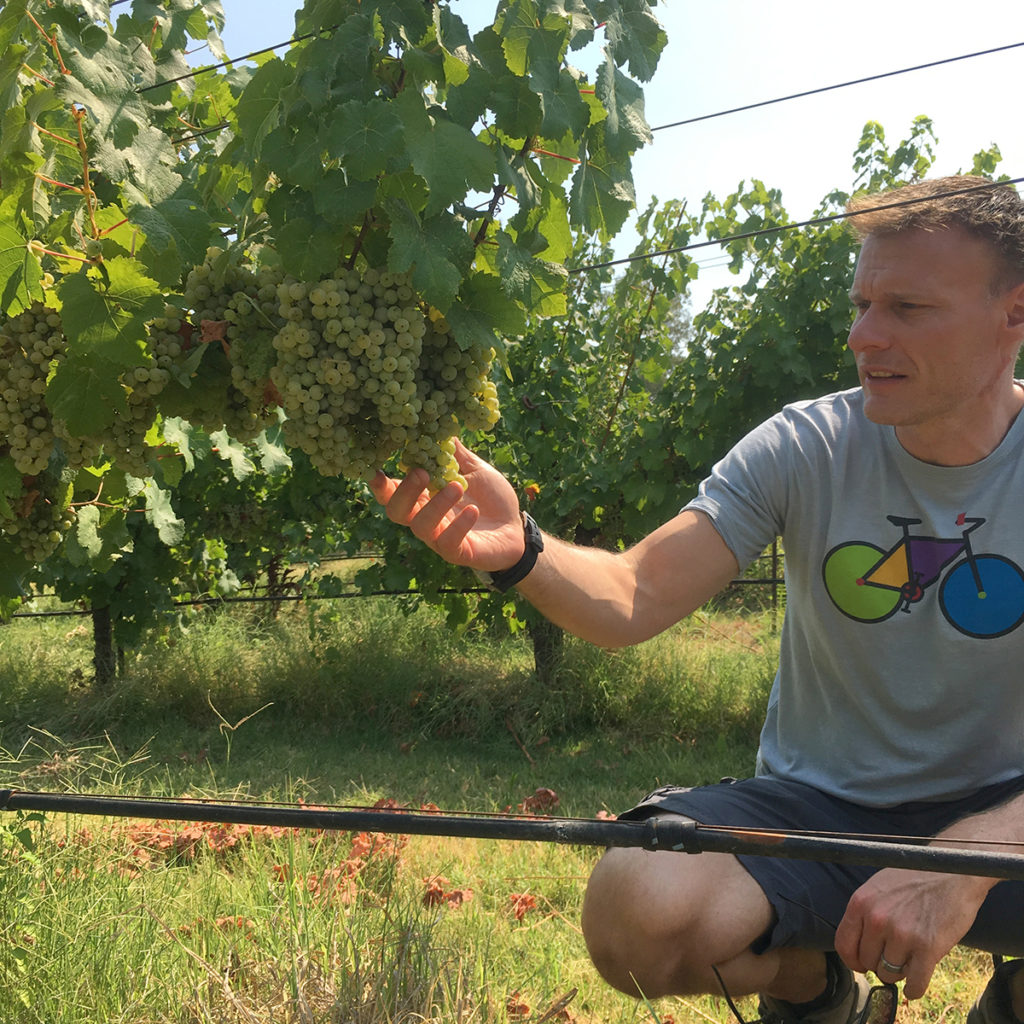
We could do better. We can do more, but the market is not really reacting as we want it. People are very, you know, they’re not that much willing to try new varietals. These are mainly hand-sells.
And so, still we see a lot of these mass Sauvignon blancs, Pinot noirs, which we shouldn’t really see coming out of here, because I believe it’s a little bit too warm for those. But we have certain spots along the river – the Mokelumne River going through Lodi – where the soils are absolute perfect, but also the temperature drops are almost forty, forty-five degrees from night to day. And so there’s really the perfect growing condition, and even a Kerner or a Riesling or then a Vermentino or a Viognier does exceptionally well.
But how is the market taking it? That’s a much different question. So, I think in my case, I believe if somebody has a palate and knows how to sell a product, that’s when you’re successful. It’s not how long you have studied in UC Davis or in other universities.
I believe that you have to understand the market. You have to follow the market, and be attentive to the market. And then trust your palate to bring out that product.
Betty:
It sounds like it’s kind of two-fold. You said your palate and then also the market is guiding your decisions. And I’ve noticed, you know, we have an opportunity to try quite a few of your wines – and they’re all fantastic by the way – but you have a lot of different varieties that you work with. And I know that Lodi’s very diverse.
So when you’re choosing, okay, we’re going to make, you know, this blend; or we’re going to put out this bottle of Gewürztraminer. I mean, how are those decisions made? Like, how are you able to come to that conclusion?
Markus:
Yes, I believe… I think everybody, every winemaker has a fingerprint. Or, in reality, probably a style.
So, me being from Switzerland, I grew up on these higher-acid white wines. So the typical German/Austrian/Swiss white wines have high acidity naturally, because they’re coming from a cooler region. And so the grapes are not really getting that ripe. And so the base is the high acidity. And I think you see this through all my wines, even the reds.
We experienced in the past three years quite a drought. With that we really have an earlier picking stage, where the grape physically is not quite ripe yet. So the acidity is still within the grape, but the sugars are up where we need to pick them.
And so, you get this easily six-and-a-half, six to six-and-a-half TA levels in the red wine, which is, might be slightly on the higher side, or not so much often seen. But I think in Europe and Spain, in France and Italy these are perfectly normal levels.
And what the benefit is about these high-acid wines in white or red, they absolutely match perfect food. So in whatever restaurant you go, you can bring these wines. And it’s no problem to have that for dinner as well. And I think that’s one of my philosophies that wine belongs on every table in my world, and it should make the food and the experience special. And I do my very best to do that. And if it’s an unknown varietal, I’m more than happy to introduce that to the consumer, as long they’re willing.
And we see with the change in the market with millennials pushing more and more, they are really want to explore these new varietals. They want to try everyday something different. It’s maybe a little bit more challenging, because we haven’t seen too much consistency in the millennial crowds. Having said that, again they are… there’s a certain price point we can bring out wine for the millennials, but we don’t see the repeat business yet in that segment. So, it’s a hit and miss, but definitely the perfect market for experiencing these varietals not known in the market.
Tony:
So, I wanted to kind of take things over to some of the things about your job about making wine.
You know, you had this shift in what you were doing around thirty years old, and it kind of, you know, took your career in a new direction. What is one of the things that you like best about your job?
Markus:
(Laughs.)
Total freedom.
I think that’s the key that every day my day looks different every day. One day I’m designing labels. The next day I’m tasting grapes. On the fourth day, I visit a glass factory, which we go over different bottle styles. Then we taste through twenty-five or forty different wines to see what is our competitors are doing. Then we go to a wine region and see how do they represent their wines? How are the tasting room structured? What’s their wine club doing? How do they sell wine? What’s their tasting fee?
So, I’ve been pulled in so many different directions, but I love it, because it gives you that perfect picture. You put these puzzle pieces together to get the clear view of what’s the next step.
So, with being out there every day, I’m guided to where I need to go tomorrow, which is really great. It’s not I’m coming here and I’m sitting on a desk and all today is exactly the same what I did yesterday.
So, I think that’s really the freedom I have. And walking in these vineyards, especially now in early September, or late August, it’s a joy, because everything is getting ripe, and there’s so many flavors, and the colors are just great, and the temperature finally dropping. So it’s just the place to be right now.
Betty:
(Imagining:) Hmm. Yeah, absolutely.
So, on the flip side of that, what is the most difficult aspect of making wine?
Markus:
The most crucial point is really: when do you pick?
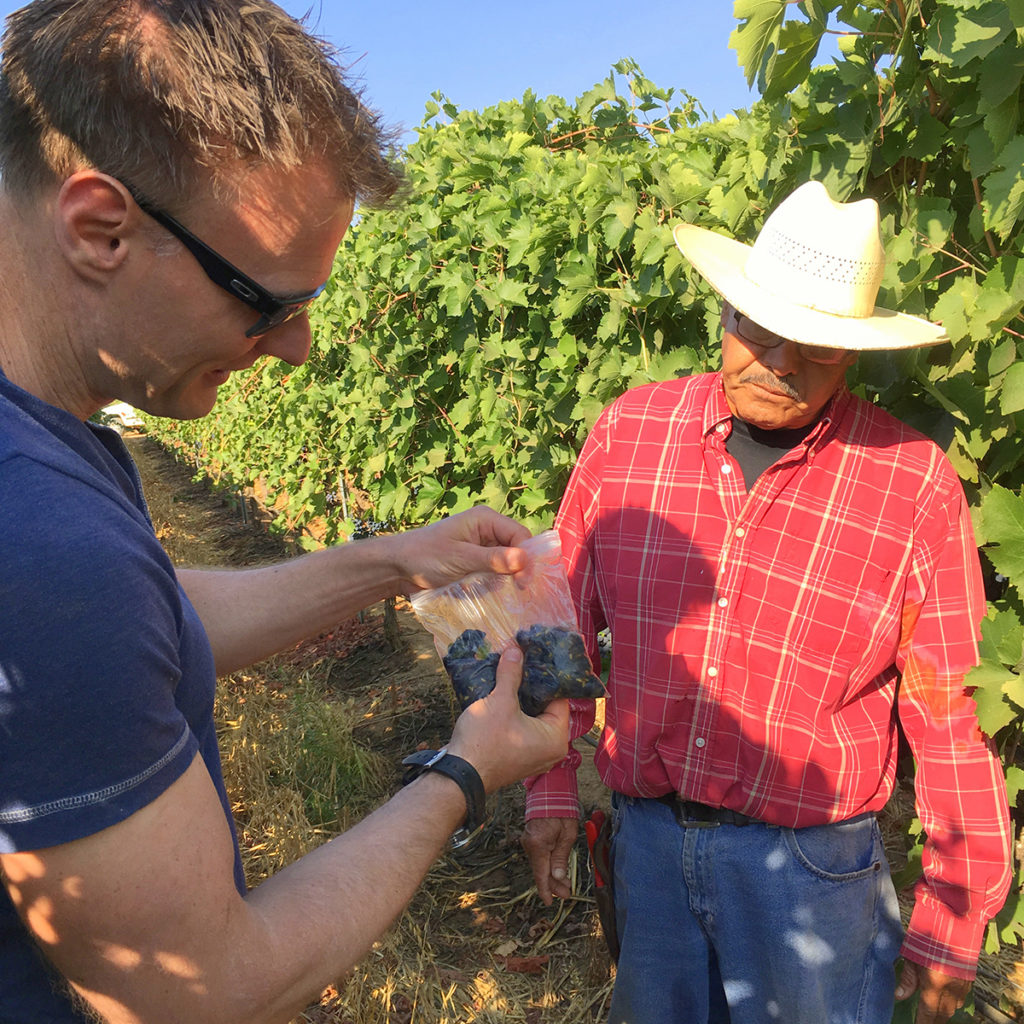
Nobody will tell you when to pick. If you hear we have no force of rain, at least not early in the game. We walk through… I do walk through these vineyards and decide pretty much by flavor when I want to pick, guided by certain numbers, of course by the sugar levels, also a little by the acidity, by the pH. I want to make sure that we have a juice I can work with so I don’t create headaches before, you know, the wine is even made.
That’s a very crucial decision, and you often make that decision after fifteen, sixteen, eighteen hours of working. And sometimes your judgement can be a little bit, you know, clouded. Or you’re just simply too tired.
We also don’t know during the fermentation, there’s a lot of things happening, and you’re pulled left and right, and making there the clear decision over every lot. The mindset has to be a hundred percent focused on what you are currently doing, otherwise the chance that you mess up that lot can be very very simple.
If then you have to correct your mistake, you will taste it down the road in the wine. And that’s especially, I’m very keen that these things never happened, but we’re all human and, again, mistakes are happening.
But it’s these daily things you don’t know what’s next, what’s coming next, because there’s always something unexpected coming up almost every day.
Tony:
Yeah.
Speaking of unexpected, or maybe even expected, do you see any possible future challenges for growing grapes and making wine in Lodi?
Markus:
Of course.
Like every wine region has its challenges, what do we see? We see wildfires left and right of us. We see water capacity, storage capacity in the soil which was extremely difficult in the past three years. We see the pattern changing.
Let’s say we are now this year in 2018, we’re about two-and-a-half weeks behind, compared to the past three years. That means we received water last year. We had a fairly cool spring, and it delays harvest.
It’s if you think that last year’s norm was the new norm, you will change again. Every year there is changes. Every year you have to really pay attention what the nature is giving you, and never ever expect that you can use last year’s numbers, or last year’s directions. Because you have to listen what the plan is telling you, and make the best out of it, because if you just copy paste last year you will fail.
Betty:
Yeah, absolutely.
That sounds like it’s something that you enjoy about making wine, but also something that makes it extremely challenging every year.
(Laughs.)
Markus:
Of course in my nature of being Swiss, we are very detail-oriented.
(Laughs.)
And so I like have it perfect. But if the nature is not really playing along with that, you have to adapt pretty quickly. Make split decisions very quickly how to react to a certain situation.
You know, you go in. You pick. You see the grapes are not ripe, just stop. While the crew is not happy, with everything lined up. You have trucking lined up. You know, crushing lined up and you stop. These are decisions you make based on quality, and it doesn’t matter if everybody surrounded is going to like you or not.
But I think the quality of the wine comes first, and that’s my only job to make sure that out there everybody is safe, but second also that the quality is up there.
And these decisions, they can really affect the vintage. With the fires there in Napa and Sonoma last year, it was totally unexpected coming that late in the season, but I think it changed a lot of mindsets up there.
And what they have there this year in Mendocino, it’s getting more and more real. And it can happen simply everywhere. It can happen down in Lodi as well, because we are bone-dry at this point. I mean the last rain we got was probably mid of April. And we don’t expect any more rain until mid-, end of October probably.
So, all within, it can happen to any of us. And these are the things you cannot foresee.
Or even flooding. We had a record winter last year, and there was so much snow melt that they had to open all the gates, and all the water reservoirs for the snow melt. And that flooded the vineyards along the river pretty badly for quite some time.
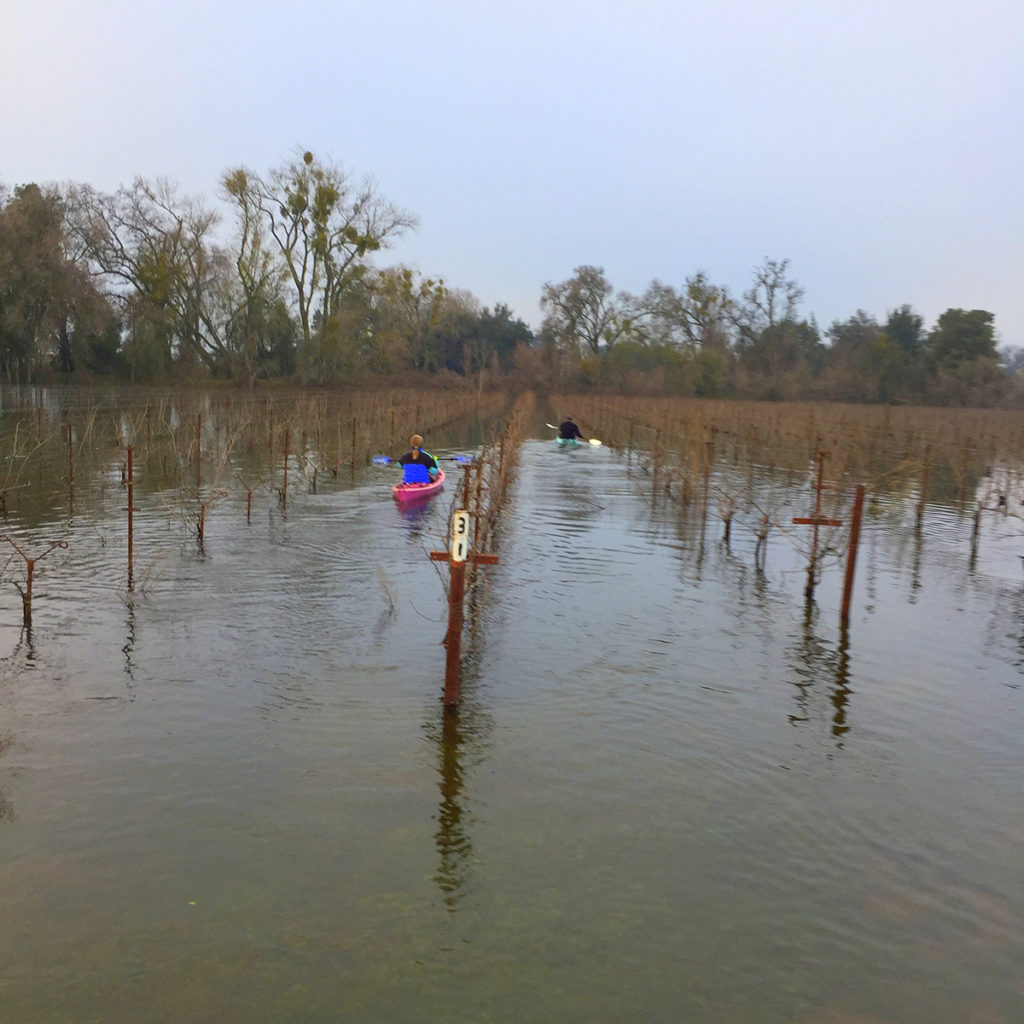
So, we had vineyards for over four months under water, and we’re talking here eight feet water. So, we had fish swimming through the vineyards in the middle of May.
And these are things you don’t expect. You don’t know what to do, because it never happened before. And you have to wait it out and see how the plan is actually reacting to it.
And what’s next year? Because there is no data available for that. And these are the things when you really plan and you sell grapes and you promise the customers perfect fruit, it’s almost… These are things out of your control. And that’s really, you know, things when you are really… I’m very well-organized, and these things are bugging me, but I have learned that’s just nature. There’s nothing you can do about it.
Betty:
Control what you can control, right?
(Laughs.)
Markus:
Correct.
(Laughs.)
The rest, just go with it.
Betty:
Exactly.
Markus:
The rest, just go with it.
Betty:
So, what’s one thing you think the average wine drinker should know?
Markus:
That’s a… That’s a big question…
What should they know?
They should know how much work goes into it.
I see a lot of inexpensive product out there. I see a lot of product. I believe there’s a clear-cut between a small winery when the people work there for fun, and they put the heart and the heart and soul into the wine.
And then there comes that moment where the winery gets bigger and bigger, produces more wines, and then it really splits up into a business. And at that point, we see then also that the quality of the wine is going down.
And in our levels, in the small producer levels, there’s so much work going in these bottles, often it’s not appreciated, you know, when the wine is consumed… I think that knowledge, or, you know, to spread that word actually explain how many steps it takes, how many people it takes, for that finished product on your table, it sometimes people are amazed.
Tony:
Alright.
So you recently kind of had a little bit of change in things with the Markus label. Previously you were making wine…
Betty:
…for another winery as well.
Markus:
Correct.
Betty:
And then that shifted.
Markus:
Well, I was working for, with Steve Borra for the last twelve years, or fourteen years, and he approached me about a year, a year-and-a-half ago and said, “Markus, I’m getting too old for this.”
So, they have the vineyard and then I was in charge for the wine, for the winery part. And they said, “Hey, Markus, why you are not running with it, and take it away from us, so we can retire? We keep the grapes. We keep the vineyards.”
But the winery is always, you know, it’s a lot of presence in the public. It is a lot of tasting room hours. It’s all on their property. And they said, “Well, for us it’s time to retire.”
And, so, I… You know, it takes a moment to, to figure out these steps. And I found a new location, and that location actually was found this April, and since then I moved the whole winery from the old location to a new location.
And within the next few weeks, Borra Vineyards’ label will disappear for a little while. The permit, the winery permit is still active. And it will stay active. He will make small amounts for himself, for a small, probably, wine club.
And I changed over, basically, all the labels over to “Markus.” So, then, “Markus” instead of “Borra Vineyards.” Same grapes. Maybe new ideas. New products. New directions, but the same people. The same quality.
Tony:
So, in your new location, do you have a tasting room?
Markus:
I have a warehouse at this point.
I’m looking after harvest, I will check out tasting room locations.
It’s in the “Victor Triangle,” which is slightly outside of Lodi. That’s where the original Lodi happened out there. It’s where we have the really old vineyards – the Kirschenmann Block, where we have the Rous Vineyards – all from the early 1900’s, and they’re all in the sandy soil. And even Tegan Passalacqua, the Turley winemaker, you know, he’s just two doors down, having opening up pretty soon his own winery for Sandlands.
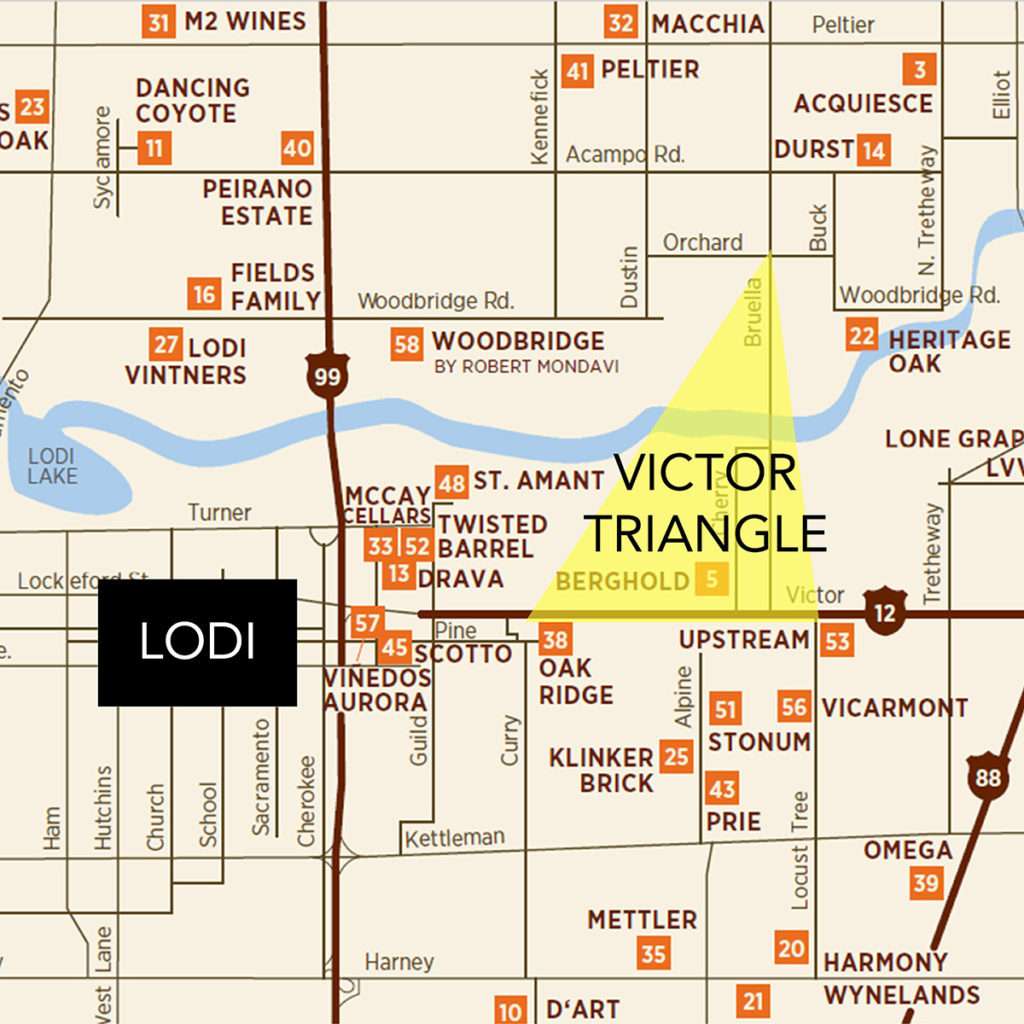
And so there’s definitely things moving, and moving forward in the right direction in that corner. Not quite sure yet if I have room in my spot to open a tasting room.
If I open a tasting room, I want to make sure it’s something different. Again, being different is the key. There’s a lot of tasting rooms opening and closing. Lodi has a lot of tasting rooms, and a lot of businesses downtown, but is struggling a little with tourism. And so we are looking.
We need the tourism, of course, and so I think the numbers twice before I do just something wild out of the blue and just opening up something different. So, I will look at it after harvest.
I will see what is a good location. Can I financially pull it at this early stage? Or do I join with somebody else? I definitely don’t want to disappear. I definitely want to have a face in town.
It will come to me, as the right location came.
Now it’s time, you know, get harvest underway. Get that finished up in a couple months. And then see what’s next when it comes to tasting room location.
Tony:
Are you doing most of the sales, the direct-to-consumer sales, through your website at this point?
Markus:
Yes.
With the transition from Borra to Markus Wine Company, there is a slight delay in, of course, permitting. So, with that comes then the state permitting for shipping. So, we ship to certain states at this point. We should be up and running within the next two weeks. That means we should be good to go for opening up more states for direct-to-consumer shipping. And we definitely focus on that.
I do have a few restaurants I work with. There is, of course, the Visitor Center here in Lodi. My wines are available for purchase.
Otherwise, I’m focusing on small wine clubs. So, a wine store has a wine club and he needs a small twenty- thirty-case production for monthly or quarterly shipment, I’m all for it. So, this is the placements I have right now.
I also don’t produce too much, between sixty to eighty cases a lot. Which is not much. But without a tasting room, I want to make sure I don’t have six vintages backlogging. And, so, I want to be current.
I want to be, so to speak, “desired.” So, once these wines are coming out, that actually people go after those. So, if I have to skip a vintage, then I will do that. I skipped a vintage in the Kerner, because of the rain and the water.
So, these are one of the issues. But also if I am long on inventory, I have no problem sitting one vintage out, because the most expensive wine is really the one sitting in the warehouse. And if you don’t have a face in town, if you don’t have an outlet to sell your wine in public, it’s quite hard to move wine, because there is over four thousand wineries in California.
So, there’s a lot of wine in the market, and it needs a little more effort to place your wines into certain spots. And I already have five different jobs, so I can only divide myself into so many different parts in my day.
And, so, if you are small you cannot just hire twenty-five people. It usually ends up on my desk. And, so, (laughs) I need to choose carefully which is next.
Betty:
Yeah, absolutely.
I definitely can understand the need to be strategic.
(Laughs.)
Markus:
Yes.
It is… I mean, your product has to make money. You cannot disappear, so you have to be out in the market.
The scores… The scores they are good. I mean these are high-scored wines. Not every magazine is looking at them, because the production is too small. And so, you know, these are all the criterias. A lot of people still go after the scores. I don’t really pay too much attention to them, but I’ve learned to mention, if needed.
(Laughs.)
So, I believe the quality shows more than anything else. And, at the end of the day, I want to make sure that Lodi finds that place on the map, because only if we are standing up as a region, we can be successful. Individual players alone will never ever pull this.
Betty:
Yeah. I mean, I think that’s what I appreciated when we had an opportunity to come out a couple of years ago to Lodi was that the collective spirit of the winemakers and grape growers in the region, and just how can we help everyone be successful. Which is something I don’t think you see in other… some other regions in California.
And I think all of your decisions and the, you know, the thought, and the intention behind it, really shows in the wine.
I know that, you know, when we came out a couple of years ago, we got an opportunity to taste mostly whites at the time.
And then just this past summer had an opportunity to taste your reds and your rosé and just definitely a lot of thought.
I think I always have a hard time finding red blends that I really enjoy. And I’ve… There wasn’t one of yours that I didn’t enjoy. I really enjoyed that you were doing some interesting things, like I always get happy when I see somebody putting Petite Sirah in a wine, because I feel like that’s like this grape that I just want to see more and more of.
And, so, yeah, we just really enjoyed your wines, and we definitely could tell the thought and the care behind it.
Markus:
You know everybody has a different palate, and so it’s hard to please every single person.
I believe in every region has a certain strength in grape growing, that means certain varietals do better in certain locations. And Lodi is definitely known for their Syrah, Petite Sirah, also for their Zinfandels, of course. And, so, if I have access to these grapes, I definitely want to work with them. If it’s just for as a blender, that’s one thing. But I just want to make sure that, that, you know, it’s representing the region by itself at its best.
And I think we see more and more that, you know, everywhere there is Chardonnay, there is Sauvignon Blanc; there is Pinot Noir, because that’s really what the market wants the most, but I don’t believe that’s showcasing the region the best, so I want to focus on the varietal that really do great, and we got to know, be known for that, you know, particular grape.
Tony:
Before we wrap things up and talk about how people can find out more information, are there any further topics you wanted to touch on?
Markus:
I just advise everybody, or, you know, encourage everybody to go out and buy wines you have never tried, from maybe regions you have never known.
And it doesn’t even have to be only from the west coast.
I’m working also in North Carolina. I’m working Tennessee. I work in different states. And a lot of these states have so much to offer. And it’s not just, “Oh, west coast is great, Finger Lakes is great and the rest is garbage.” And I think we passed a long time… You know, Minnesota has great, great wines. So does Illinois. So does, you know, Texas has a great wine industry. And, you know, of course, we know Oregon and Washington State, they do great.
And try, try. There’s a lot of product out there. There’s a lot of different wines out there. Don’t be scared from names you cannot pronounce, you’ve never heard of. Or varietals. Don’t be scared of that fifty-five- to seventy-five-dollar wine. But also don’t be scared of the two-dollar bottle to see, you know, what is your price point, what do you like.
Find your own style of wine and make wine help to create the memory or the, you know, the friendship you’re looking for.
And that’s really… There’s much more behind wine than you think. And I hope that the wine industry is growing, and will find its place. I mean, it’s a big multi-billion-dollar production already out there. But I think a lot of people have very little knowledge about wine. And there’s a lot of information out there, and I’m more than happy to help people to, you know, to find the right direction if they want to taste, and they want to come by and learn a bit more about wine, I’m more than happy to do my part.
I think it takes all of us in the wine industry to make, you know, to educate the people in their styles and what they might look for in wine. And again, every palate is different.
So, yeah, be open. Be open to something new, something different. And, yeah, enjoy wine on every night on the table.
Betty:
I think you just summed-up the whole reason our podcast exists. So, thank you for that.
(Laughs.)
Markus:
(Laughs.)
You’re welcome!
Betty:
So, before we go, you said people can connect with you. How can they connect with you?
Markus:
Yes.
We have the website MarkusWine.com. There is definitely our latest progress on it. There’s the wines available. They’re mainly on line.
There’s Instagram. We’re Instagram. We have Facebook.
There’s also the most traditional version: you come to Lodi and you call us, and say, “Hey, can I stop by?” And we’re more than happy to spend some time with whoever comes by, to actually make the effort and wants to come see us.
Or, then, with the product in different locations, like restaurants, or, in my case, the restaurants are not that widely-available at this point. It’s more of a local side.
But I’m working on getting my wines outside of state as well into certain places to make it available.
But at this point really it’s www.MarkusWine.com.
Tony:
And that’s Markus with a “K.”
Markus:
Right. Correct.
(Laughs.)
For me it’s the most normal thing, but everybody else writes it with a “C.” And, so, it wouldn’t pop up. And, so, yes, Markus with a “K.”
Betty:
Big thanks again to Markus for taking time out of his busy schedule to talk with us.
A few months ago, we were sent some samples of his wine to try. And we’re going to talk about a few of our favorites, but, honestly, we enjoyed all the wines we tried.
There were six in total. We’re not going to talk about all six right now, but we’ll definitely have the tasting notes and more information about those wines on our show notes page, so definitely check that out.
So, we each picked a wine that we wanted to talk about, and the wine that I really wanted to talk about, considering that it’s the end of August right now – still plenty of warm weather – is the Zeal Rosé. We had the 2017.
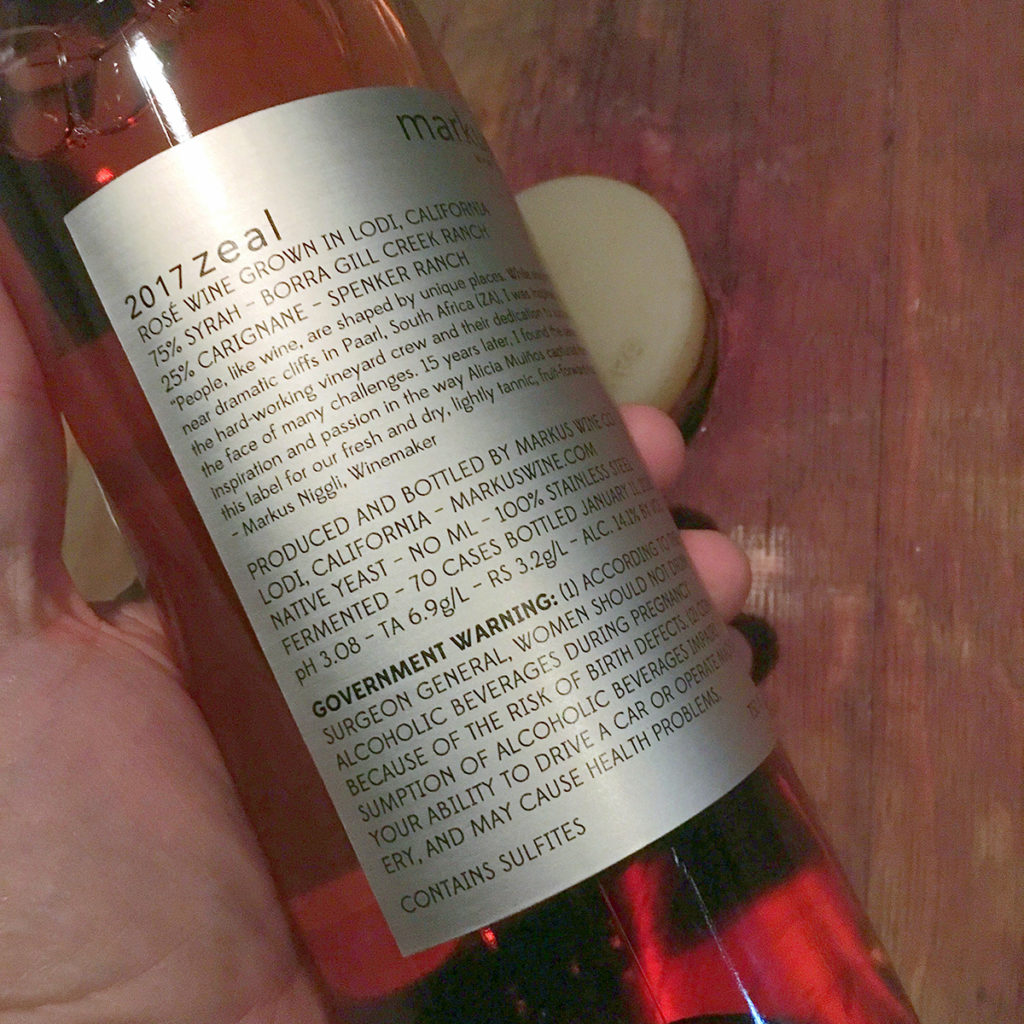
So, this is actually a blend of mostly Syrah: seventy-five percent Syrah and twenty-five percent Carignane.
And this was this beautiful, like bright pink color, and that comes from the Syrah grape. You know, if you’re getting a rosé from Provence, it’s generally paler. It’s lighter, but the Syrah and the skin contact really amped-up the pink color in this particular wine.
And we got a nose of minerality, dusty rose, and strawberries.
This is a dry rosé. It has medium-plus acidity – plenty of acidity to pair with your favorite light dish in the summer. We got flavors of strawberries, watermelon, pink grapefruit, and a hint of rose.
So, very fruity, very refreshing. Exactly what you want for hot weather.
It’s also got just a little hint of tannins. It gives it this really nice texture, like if you could imagine the texture of running your hands along soapstone countertop, like that texture. Translate that into what you would experience when drinking this wine. And like I said, just really crisp, fruity and complex.
Rosé’s super-popular right now, and I think the danger with that – and we’ve talked about this on this podcast – is that people are pumping out rosé – not everyone – but there’s a chunk of people that are pumping out rosé, because that’s what sells right now, but this is one that you definitely could tell Markus has spent time really working on the blend, getting the right amount of skin contact, and making just this really delicious, refreshing wine.
And this goes back to Markus’s style. He’s European, so those crisp, acidic, light wines, very complex, very refreshing, like that’s just his style that he is able to bring into Lodi.
And I love this wine. It was fantastic. It’s probably one of the best rosés I’ve ever had.
Tony:
And the wine I wanted to talk about was the Sol. And we had 2015. This is S-O-L, like the sun.
This wine is forty-two percent Petite Sirah, thirty-seven percent Syrah, and twenty-one percent Mourvèdre. And I love how Markus puts even along with the percentages on the bottle, the vineyards, and even the block from the vineyards where the wines came from. I think that’s super-cool. You know, we talk a lot about transparency on our podcast, he’s telling you exactly what you’re getting in that bottle.
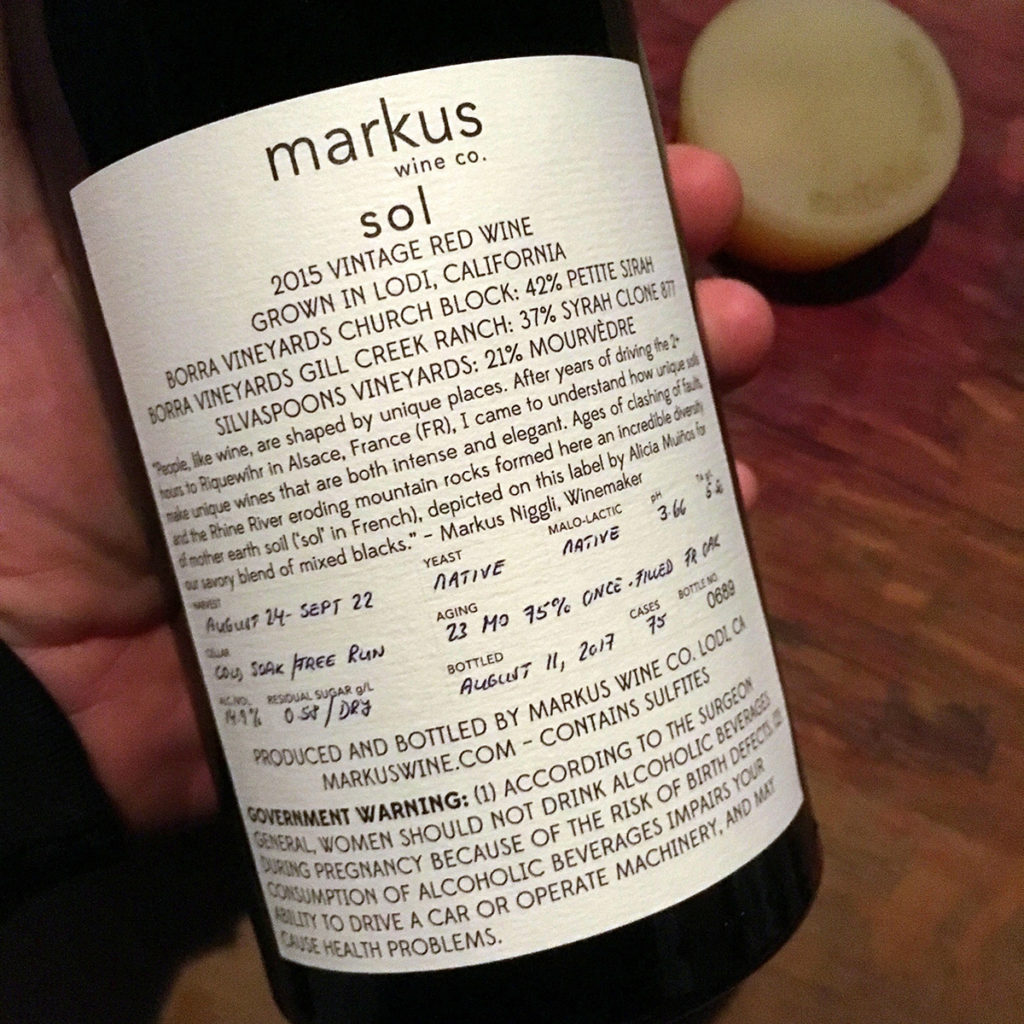
This wine gave us a nose with pepper, stewed dark fruits, like blackberries, and some vanilla.
It’s a full-boded, dry wine, with medium acidity, and we got medium, velvety tannins, and flavors of blackberries, black plum, cedar, and a hint of just a little bit of bitter tobacco.
This wine is juicy, ripe; it’s bursting with dark fruit flavors. The texture’s rich and creamy. It’s everything you want coming from a region like Lodi that can get fruit ripe.
We had some of my co-workers over a little while after we had opened this wine and done our tasting notes for it, and I got to share a little bit of this with each of them. And, this is just that kind of wine that you want to share.
This is such an impressive wine. You want to – even your co-workers that don’t necessarily know about wine – you want to give them that taste of it and be like, “Hey, this is something really special.” And that’s what this wine is for me.
It’s just a wine that you want to share. It’s so good. It’s priced around thirty-nine dollars. And, again, that’s the Sol. And we had the 2015.
Betty:
So, again, a big thank you to Markus for chatting with us and sharing his amazing wines.
So, you can get our tasting notes, as well as links to purchase, out on our show notes page at WeeklyWineShow.com/130.
We’d also love it if you’d go check out Markus’s website as well. You can get lots of details about the wine, and updates about how things are going at the winery at MarkusWine.com. And that’s “Markus” with a “K,” not a “C.”
Again, thank you so much for listening, and we will see you next time for another…
Betty and Tony:
…Weekly Wine Show!
[All of Tony’s and Betty’s notes on our wines can be found on their Episode 130 page. Transcribed with permission from Weekly Wine Show.]
